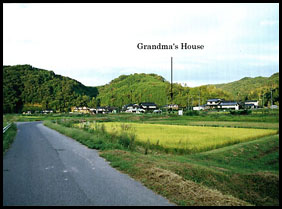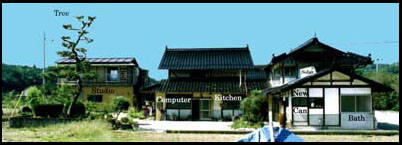|
 |
|
 |
Yanochi village sits along a river in a
quiet valley about two hours west by car from the city of Hiroshima.
Miyoshi, a city of some 40,000 people, is one-half hour away by car.
The closest town is Kisa, ten minutes away by bicycle with an approximate
population of 5,000. Yanochi itself includes about fifteen houses,
and most of the families have occupied and farmed the same land for centuries.
Recently, people in Japan have been moving
away from the countryside in favor of the faster paced, bigger cities.
So abandoned old houses and overgrown, unused rice fields are a common
sight. Such was the apparent fate of the house in which I'd chosen
to live. However, after several months of cleaning and some repairs,
the house became habitable again. The main part of the house (yellowish
walls in photo) was constructed about 80 years ago, with additional sections
added over time. The inside of the house is about as traditional
as you can get, farmer style, somewhat different from the more refined
Kyoto style often seen in typical representations of Japanese culture.
Sliding doors made of rice paper or wood with glass panels separate the
rooms. Tatami mats constitute all of the floors except the kitchen,
which is now cement. 
A new wing was added to the house during the 1970's. It replaced a cow shed and a traditional bath with more living space. At that time, at least eight people lived here. Now I keep the wing closed and empty because I have no need for so much space. The open hole toilet has been replaced by an ultra-modern heated system with running water and bacterial cleaning.
Now the second floor of the main house,
which used to house the silk cocoons, is used as a watercolor studio.
It has big windows that allow in a lot of light for most of the afternoon.
An additional building outside, where the tractor and farm tools used to
be stored,
The neighbors are primarily farmers, and their average age must be around seventy. Very few of the children of the area have chosen to reside in their houses, favoring instead the big cities. This must be a very strange time in Japan, where all of the elder people must take care of themselves and do all of their farming without help from younger generations. The house shown here has large vegetable and flower gardening areas as well, but to maintain such a garden would require more work and knowledge than I can afford. The best I can do is try to keep the never-ending weeds under control!

Top | Yanochi | Scenes | Flowers